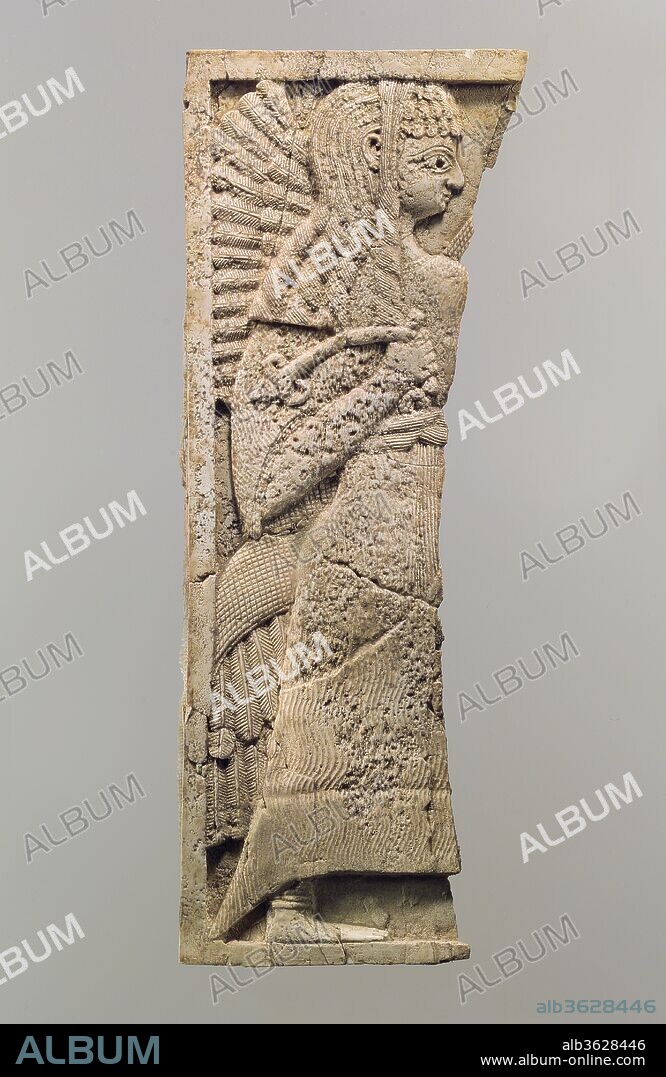alb3628446
Furniture plaque carved in relief with standing woman

|
Añadir a otro lightbox |
|
Añadir a otro lightbox |



¿Ya tienes cuenta? Iniciar sesión
¿No tienes cuenta? Regístrate
Compra esta imagen
Título:
Furniture plaque carved in relief with standing woman
Descripción:
Ver traducción automática
Furniture plaque carved in relief with standing woman. Culture: Assyrian. Dimensions: 9.96 x 3.74 in. (25.3 x 9.5 cm). Date: ca. 9th-8th century B.C..
This ivory panel was found in a storage room in Fort Shalmaneser, a royal building at Nimrud that was used to store booty and tribute collected by the Assyrians while on military campaign. Like many other panels from the same storage room, it was part of a chair or couch back or the headboard of a bed. Twenty pieces of furniture were discovered stacked in orderly rows in this room, where they had been stored before the destruction of the Assyrian palaces in 612 B.C.
Shown here is a finely carved winged female figure, dressed in a long garment belted at the waist, made of a material with an overall design of delicate wavy lines. The panel is broken on the right side, so much of the figure's left side is missing, although one bare foot remains with heavy anklets visible below the hem of the dress. She wears her hair in long locks, with smaller curls above the forehead, and grasps a long stalk of vegetation ending in a volute in a fist held to her chest. The figure's association with thriving vegetation suggests concepts of abundance and fruitfulness connected with the agricultural cycle. Like the other panels from this storage room, this piece is classified as North Syrian in style because of its carving technique; the dynamic composition, in which the image fills the entire frame; and the figure's characteristic facial features, including large eyes and nose, small mouth, full cheeks, and receding chin.
Built by the Assyrian king Ashurnasirpal II, the palaces and storerooms of Nimrud housed thousands of pieces of carved ivory. Most of the ivories served as furniture inlays or small precious objects such as boxes. While some of them were carved in the same style as the large Assyrian reliefs lining the walls of the Northwest Palace, the majority of the ivories display images and styles related to the arts of North Syria and the Phoenician city-states. Phoenician style ivories are distinguished by their use of imagery related to Egyptian art, such as sphinxes and figures wearing pharaonic crowns, and the use of elaborate carving techniques such as openwork and colored glass inlay. North Syrian style ivories tend to depict stockier figures in more dynamic compositions, carved as solid plaques with fewer added decorative elements. However, some pieces do not fit easily into any of these three styles. Most of the ivories were probably collected by the Assyrian kings as tribute from vassal states, and as booty from conquered enemies, while some may have been manufactured in workshops at Nimrud. The ivory tusks that provided the raw material for these objects were almost certainly from African elephants, imported from lands south of Egypt, although elephants did inhabit several river valleys in Syria until they were hunted to extinction by the end of the eighth century B.C.
Técnica/material:
MARFIL
Periodo:
NEOASIRIO
Museo:
Metropolitan Museum of Art, New York, USA
Crédito:
Album / Metropolitan Museum of Art, NY
Autorizaciones:
Modelo: No - Propiedad: No
¿Preguntas relacionadas con los derechos?
¿Preguntas relacionadas con los derechos?
Tamaño imagen:
2753 x 4234 px | 33.3 MB
Tamaño impresión:
23.3 x 35.8 cm | 9.2 x 14.1 in (300 dpi)
 Pinterest
Pinterest Twitter
Twitter Facebook
Facebook Copiar enlace
Copiar enlace Email
Email
